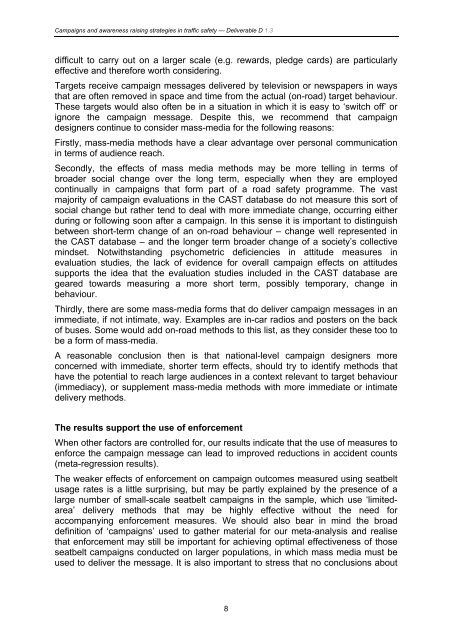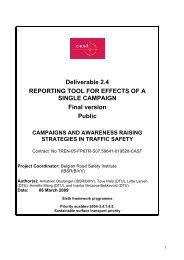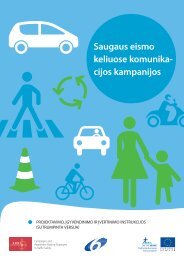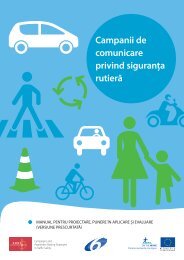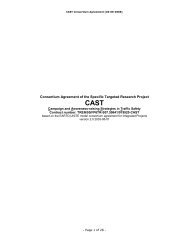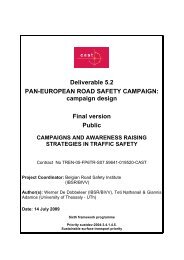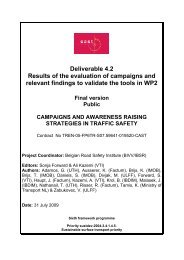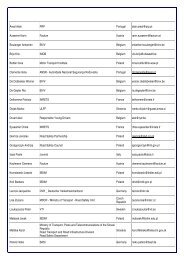Deliverable D 1.3 RESULTS OF META-ANALYSIS ... - cast-eu.org
Deliverable D 1.3 RESULTS OF META-ANALYSIS ... - cast-eu.org
Deliverable D 1.3 RESULTS OF META-ANALYSIS ... - cast-eu.org
You also want an ePaper? Increase the reach of your titles
YUMPU automatically turns print PDFs into web optimized ePapers that Google loves.
Campaigns and awareness raising strategies in traffic safety — <strong>Deliverable</strong> D <strong>1.3</strong>difficult to carry out on a larger scale (e.g. rewards, pledge cards) are particularlyeffective and therefore worth considering.Targets receive campaign messages delivered by television or newspapers in waysthat are often removed in space and time from the actual (on-road) target behaviour.These targets would also often be in a situation in which it is easy to ‘switch off’ orignore the campaign message. Despite this, we recommend that campaigndesigners continue to consider mass-media for the following reasons:Firstly, mass-media methods have a clear advantage over personal communicationin terms of audience reach.Secondly, the effects of mass media methods may be more telling in terms ofbroader social change over the long term, especially when they are employedcontinually in campaigns that form part of a road safety programme. The vastmajority of campaign evaluations in the CAST database do not measure this sort ofsocial change but rather tend to deal with more immediate change, occurring eitherduring or following soon after a campaign. In this sense it is important to distinguishbetween short-term change of an on-road behaviour – change well represented inthe CAST database – and the longer term broader change of a society’s collectivemindset. Notwithstanding psychometric deficiencies in attitude measures inevaluation studies, the lack of evidence for overall campaign effects on attitudessupports the idea that the evaluation studies included in the CAST database aregeared towards measuring a more short term, possibly temporary, change inbehaviour.Thirdly, there are some mass-media forms that do deliver campaign messages in animmediate, if not intimate, way. Examples are in-car radios and posters on the backof buses. Some would add on-road methods to this list, as they consider these too tobe a form of mass-media.A reasonable conclusion then is that national-level campaign designers moreconcerned with immediate, shorter term effects, should try to identify methods thathave the potential to reach large audiences in a context relevant to target behaviour(immediacy), or supplement mass-media methods with more immediate or intimatedelivery methods.The results support the use of enforcementWhen other factors are controlled for, our results indicate that the use of measures toenforce the campaign message can lead to improved reductions in accident counts(meta-regression results).The weaker effects of enforcement on campaign outcomes measured using seatbeltusage rates is a little surprising, but may be partly explained by the presence of alarge number of small-scale seatbelt campaigns in the sample, which use ‘limitedarea’delivery methods that may be highly effective without the need foraccompanying enforcement measures. We should also bear in mind the broaddefinition of ‘campaigns’ used to gather material for our meta-analysis and realisethat enforcement may still be important for achieving optimal effectiveness of thoseseatbelt campaigns conducted on larger populations, in which mass media must b<strong>eu</strong>sed to deliver the message. It is also important to stress that no conclusions about8


